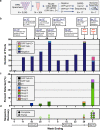Molecular evidence of SARS-CoV-2 in New York before the first pandemic wave
- PMID: 34103497
- PMCID: PMC8187428
- DOI: 10.1038/s41467-021-23688-7
Molecular evidence of SARS-CoV-2 in New York before the first pandemic wave
Abstract
Numerous reports document the spread of SARS-CoV-2, but there is limited information on its introduction before the identification of a local case. This may lead to incorrect assumptions when modeling viral origins and transmission. Here, we utilize a sample pooling strategy to screen for previously undetected SARS-CoV-2 in de-identified, respiratory pathogen-negative nasopharyngeal specimens from 3,040 patients across the Mount Sinai Health System in New York. The patients had been previously evaluated for respiratory symptoms or influenza-like illness during the first 10 weeks of 2020. We identify SARS-CoV-2 RNA from specimens collected as early as 25 January 2020, and complete SARS-CoV-2 genome sequences from multiple pools of samples collected between late February and early March, documenting an increase prior to the later surge. Our results provide evidence of sporadic SARS-CoV-2 infections a full month before both the first officially documented case and emergence of New York as a COVID-19 epicenter in March 2020.
Conflict of interest statement
R.S. is VP of Technology Development and a stockholder at Sema4, a Mount Sinai Venture. This work, however, was conducted solely at Icahn School of Medicine at Mount Sinai. Otherwise, the authors declare no competing interests.
Figures


Similar articles
-
Pooling Nasopharyngeal Swab Specimens to Increase Testing Capacity for SARS-CoV-2.Med J (Ft Sam Houst Tex). 2021 Jan-Mar;(PB 8-21-01/02/03):8-11. Med J (Ft Sam Houst Tex). 2021. PMID: 33666905
-
The Potential Transmission of SARS-CoV-2 from Patients with Negative RT-PCR Swab Tests to Others: Two Related Clusters of COVID-19 Outbreak.Jpn J Infect Dis. 2020 Nov 24;73(6):399-403. doi: 10.7883/yoken.JJID.2020.165. Epub 2020 May 29. Jpn J Infect Dis. 2020. PMID: 32475877
-
Identification of Epidemiological Traits by Analysis of SARS-CoV-2 Sequences.Viruses. 2021 Apr 27;13(5):764. doi: 10.3390/v13050764. Viruses. 2021. PMID: 33925388 Free PMC article.
-
Viral dynamics in the Upper Respiratory Tract (URT) of SARS-CoV-2.Infez Med. 2020 Dec 1;28(4):486-499. Infez Med. 2020. PMID: 33257622
-
Paradigm Shifts in Cardiac Care: Lessons Learned From COVID-19 at a Large New York Health System.Curr Probl Cardiol. 2021 Mar;46(3):100675. doi: 10.1016/j.cpcardiol.2020.100675. Epub 2020 Jul 31. Curr Probl Cardiol. 2021. PMID: 32888698 Free PMC article. Review.
Cited by
-
Sequential intrahost evolution and onward transmission of SARS-CoV-2 variants.Nat Commun. 2023 Jun 3;14(1):3235. doi: 10.1038/s41467-023-38867-x. Nat Commun. 2023. PMID: 37270625 Free PMC article.
-
Patient-Related Metadata Reported in Sequencing Studies of SARS-CoV-2: Protocol for a Scoping Review and Bibliometric Analysis.medRxiv [Preprint]. 2024 Mar 5:2023.07.14.23292681. doi: 10.1101/2023.07.14.23292681. medRxiv. 2024. Update in: JMIR Res Protoc. 2025 Apr 22;14:e58567. doi: 10.2196/58567. PMID: 37503241 Free PMC article. Updated. Preprint.
-
The evolution and epidemiology of H3N2 canine influenza virus after 20 years in dogs.Epidemiol Infect. 2025 Mar 5;153:e47. doi: 10.1017/S0950268825000251. Epidemiol Infect. 2025. PMID: 40040347 Free PMC article.
-
Patient-Related Metadata Reported in Sequencing Studies of SARS-CoV-2: Protocol for a Scoping Review and Bibliometric Analysis.JMIR Res Protoc. 2025 Apr 22;14:e58567. doi: 10.2196/58567. JMIR Res Protoc. 2025. PMID: 40262134 Free PMC article.
-
RT-PCR/MALDI-TOF Diagnostic Target Performance Reflects Circulating SARS-CoV-2 Variant Diversity in New York City.J Mol Diagn. 2022 Jul;24(7):738-749. doi: 10.1016/j.jmoldx.2022.04.003. Epub 2022 May 4. J Mol Diagn. 2022. PMID: 35525388 Free PMC article.
References
Publication types
MeSH terms
Grants and funding
LinkOut - more resources
Full Text Sources
Medical
Miscellaneous

